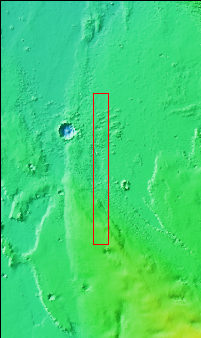
|
Amazonis Mensa
- Click the image above for a larger view
- Full-Res JPEG (1212 x 5304) (511.3 kB)
- Full-Res TIFF (1212 x 5304) (3.0 MB)
Caption:

Context image
Today's VIS image shows part of the wind eroded Amazonis Mensa. Just one of several large linear mounds of material, Amazonis Mensa has been carved by long term surface winds. The linear grooves are aligned with the prevailing winds. The mensa has to be formed of soft, relatively uncemented materials to be eroded so easily. It has been suggested that the surface material may be volcanic ash from nearby volcanoes.
Orbit Number: 79493 Latitude: 1.56883 Longitude: 210.942 Instrument: VIS Captured: 2019-11-15 18:32
Background Info:
Please see the THEMIS Data Citation Note for details on crediting THEMIS images.
NASA's Jet Propulsion Laboratory manages the 2001 Mars Odyssey mission for NASA's Science Mission Directorate, Washington, D.C. The Thermal Emission Imaging System (THEMIS) was developed by Arizona State University, Tempe, in collaboration with Raytheon Santa Barbara Remote Sensing. The THEMIS investigation is led by Dr. Philip Christensen at Arizona State University. Lockheed Martin Astronautics, Denver, is the prime contractor for the Odyssey project, and developed and built the orbiter. Mission operations are conducted jointly from Lockheed Martin and from JPL, a division of the California Institute of Technology in Pasadena.
Cataloging Keywords:
| Name | Value | Additional Values |
|---|---|---|
| Target | Mars | |
| System | ||
| Target Type | Planet | |
| Mission | 2001 Mars Odyssey | |
| Instrument Host | Mars Odyssey | |
| Host Type | Orbiter | |
| Instrument | Thermal Emission Imaging System (THEMIS) | |
| Detector | ||
| Extra Keywords | Grayscale, Thermal, Volcano | |
| Acquisition Date | ||
| Release Date | 2020-02-11 | |
| Date in Caption | 2019-11-15 | |
| Image Credit | NASA/JPL-Caltech/ASU | |
| Source | photojournal.jpl.nasa.gov/catalog/PIA23702 | |
| Identifier | PIA23702 | |
